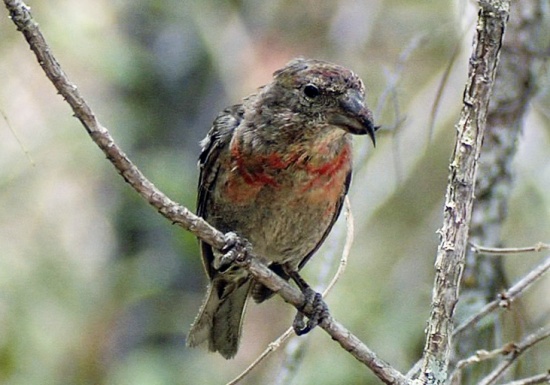
Photo © by caribemotion
Sierra de Bahoruco, Dominican Republic, December 2008
- Loxia megaplaga
Identification
Length 15-16 cm (6-6¼ in), weight 26-30 g
- Broad white wing bars
- Large crossed mandibles
- Forked tail
Similar Species
Similar to White-winged Crossbill, differing in minor details of plumage, with tertials less strongly white-tipped, and bill slightly stouter.
Distribution
Cordillera Central of Dominican Republic and adjacent Haiti.
Vagrant in Jamaica.
Taxonomy
It was formerly regarded as conspecific with the Two-barred Crossbill Loxia leucoptera, from which it is now assumed it evolved.
It has been suggested that the origin of L. megaplaga can be traced to southern populations of L. leucoptera which got stranded on the highest pine-forested mountains of Hispaniola (the highest in all the Caribbean islands) when the glaciers and the cold started receding northward, as did the vast coniferous forests, after end of the last ice age, when the Holocene epoch began, some 10,000 years ago. The distance that now separates both species is of thousands of kilometers (from the Caribbean to the northern U.S. and Canada), making the story of the Hispaniola Crossbill an interesting one from an ecological and environmental point of view.
This is a monotypic species[1].
Habitat
Hispaniolan Pine Pinus occidentalis forests.
Behaviour
Diet
Feeds almost exclusively on the seeds of Hispaniolan Pine, extracted from the cones by twisting its bill between the cone scales.
Breeding
They construct a deep cup nest from a variety of materials such as twigs, plant fibres, roots, moss, lichens, bark strips, grass, animal hair and feathers.
References
- Clements, J. F., T. S. Schulenberg, M. J. Iliff, S. M. Billerman, T. A. Fredericks, B. L. Sullivan, and C. L. Wood. 2019. The eBird/Clements Checklist of Birds of the World: v2019. Downloaded from http://www.birds.cornell.edu/clementschecklist/download/
- Clement, P. (2020). Hispaniolan Crossbill (Loxia megaplaga). In: del Hoyo, J., Elliott, A., Sargatal, J., Christie, D.A. & de Juana, E. (eds.). Handbook of the Birds of the World Alive. Lynx Edicions, Barcelona. (retrieved from https://www.hbw.com/node/61412 on 2 February 2020)
Recommended Citation
- BirdForum Opus contributors. (2024) Hispaniola Crossbill. In: BirdForum, the forum for wild birds and birding. Retrieved 27 April 2024 from https://www.birdforum.net/opus/Hispaniola_Crossbill



